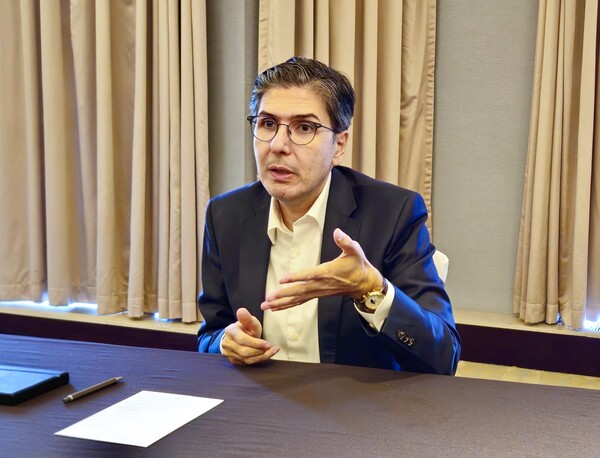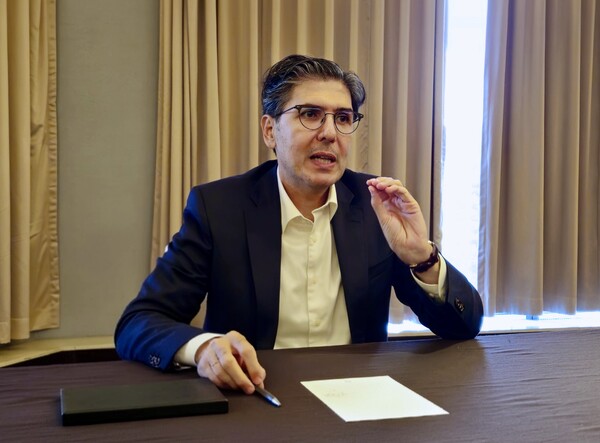
Ziyad Al-Aly, the Washington University epidemiologist whose data-driven work helped cement Long Covid on policy agendas, arrived in Korea with a blunt headline: despite vaccines and oral antivirals, the world is “probably less prepared now than it was in 2019.”
The warning landed as Shionogi announced that the FDA has accepted its application to expand Xocova (ensitrelvir) for use as an oral post-exposure prophylaxis, a potential first-in-class label in the U.S. that would sit between vaccination and treatment.
In back-to-back appearances, first at a national keynote and then in an interview with Korea Biomedical Review at the Sheraton Grand Incheon Hotel last Friday, Al-Aly urged officials and manufacturers to treat Long Covid as a systems problem.
His prescription was to set indoor-air standards, drill domestic surge capacity for personal protective equipment (PPE) such as masks and respirators along with diagnostics and medicines, and broaden the countermeasure shelf beyond Pfizer’s Paxlovid (nirmatrelvir/ritonavir) and MSD’s Lagevrio (molnupiravir), and yearly boosters to include post-exposure prophylaxis (PEP), mucosal vaccines, and longer-lasting platforms.
“Covid is still around,” he said, and in some people it “can also leave long term consequences or long term health effects.”
Japan’s Shionogi, working with Korean partner Ildong Pharmaceutical, said the FDA accepted for review its application to let antiviral med Xocova to be used to prevent infection after a known exposure, and set June 16, 2026, as its target date for a decision.
The filing cites the global phase 3 SCORPIO-PEP trial in household contacts (n=2,041): 2.9 percent on drug developed Covid versus 9 percent on placebo, a 67 percent relative risk reduction. In an expanded analysis (n=2,387), incidence was 4.4 percent vs. 10.2 percent. Adverse events were similar (15.1% vs. 15.5%), with no Covid-related hospitalizations or deaths reported.
Xocova is already sold in Japan and Singapore; the FDA has granted Fast Track for the PEP use, and reviews are under way in the EU and Taiwan.
For payers and public-health agencies, a PEP label would create a new operational layer in settings such as nursing homes, household clusters and inpatient outbreaks. It would also raise familiar questions: who qualifies, when is it deployed, and how is exposure verified at scale?
Al-Aly’s view: that is a reason to write protocols now, alongside procurement plans that guarantee pills are stocked where they will be used.
Redundancy, drills, and a broader vaccine play

Al-Aly’s policy case builds on findings he recapped from the podium: Long Covid presents across organ systems; risks rise with the severity of acute illness; reinfections can induce new problems or worsen existing ones; and vaccination plus timely antivirals is associated with lower post-acute risk.
The question for ministries, manufacturers and regulators is speed: how quickly those facts translate into operations that hold under stress.
He started with what can be engineered. Ventilation and filtration upgrades, “buildings that are also pandemic proof,” as he put it, should be standard in schools, subways, clinics and offices. He called them a once-and-done capital expense that reduces transmission even when behavior and attention flag.
Then supply: in early 2020, mask shortages forced ICU teams to reuse N95s; Al-Aly did it himself. The next pinch point may be filters, swabs or a diagnostic widget rather than masks.
His prescription is administrative: decide now how many you will need, rotate a reserve, and rehearse industrial surge so factories can switch lines and ramp output in days. The goal is muscle memory to “push a button” and stand up domestic production “within a week.” The stakes were plain: “We shouldn’t have to make the same mistake twice.”
For drugmakers, he argued for redundancy in the medicine cabinet. “There is such a thing as antiviral resistance,” he said; no country should plan multiple winters around one protease inhibitor and a nucleoside analog.
PEP adds a new use case if cleared -- but the broader hedge, in his telling, is to invest in mucosal platforms that blunt spread and in more durable vaccines that don’t fade on the timeline that forces annual campaigns for older adults. “If we develop vaccine technologies that are more durable then people can get one shot and it can last them for 5 years or 10 years,” he said, pointing to pan-coronavirus approaches as “certainly possible” on a five- to ten-year horizon.
What it means for Korea -- and why Al-Aly’s voice matters

Al-Aly is best known for large, peer-reviewed studies using electronic health-record data that quantified excess risks for heart, kidney, metabolic and neurologic disease after Covid. That work helped push Long Covid from anecdote into health-system budgets. In Incheon last week, though, his focus was less on debate and more on execution. Fatigue, he said, does not determine risk. Operations do.
Korea, he argued, is better positioned than most to take the lead. He pointed to the country’s universal coverage and a culture that normalizes masking when people are sick, calling it “excellent,” and highlighted its real-world data infrastructure. Korean teams have already used those datasets to chart Long Covid’s multiorgan effects and to show how vaccination or early use of antivirals can lower the risk of lingering complications.
That effort includes a national Long Covid cohort of roughly 9,000 to 10,000 patients, which he called a “gold mine” for discovery. The registry, he said, could unlock answers on mechanisms, immunobiology, and disease trajectories, and most importantly provide a platform for testing treatments. The danger, he warned, is that pandemic fatigue could siphon support before those investments have a chance to pay off.
He also pulled the conversation down to the clinic. Most patients start with family doctors, not specialty centers, and five years into a new condition the front line is still improvising. “I don’t think that we have enough primary care physicians who are actually equipped and empowered with the knowledge and the resources to deal with long Covid,” he said.
That gap, he added, is not about intent but about timing. Doctors who trained in 2005 or 2010 “didn’t get taught about long Covid.” The fix is practical: case-finding checklists, referral pathways, and continuing education that turn trial data into patient care.
The paradox, and the edge of his warning, is that the same period produced rapid progress at scale: vaccines reached patients in about 11 months, oral antivirals followed within the next year, and by his count researchers have already published more than 40,000 papers on Long Covid.
And yet politicization and eroded trust, he said, have left systems “probably less prepared now than it was in 2019.” His prescription is to turn settled evidence into repeatable practice: indoor-air standards that outlast news cycles, a surge plan that any duty officer can activate, a broader antiviral and vaccine shelf so resistance does not leave countries exposed in winter, and primary care teams trained to keep Long Covid patients from being bounced between clinics.
“Science is universal and truth is universal,” he said before leaving our interview. Technologies proven today, he added, are the ones that will be redeployed in the next crisis, including an oral post-exposure pill now under FDA review. The obligation, as he framed it, is simple: build the systems so that when it is time to “push a button,” both the factory floor and the clinic know what to do.
Related articles
- Long Covid plagues 400 million worldwide, requiring response systems through international cooperation: US expert
- Top court to decide on oriental medicine practitioners’ access rights to Covid-19 info system
- HK inno.N, Pfizer Korea sign co-promotion deal for updated Covid-19 vaccine
- Moderna Korea wins approval for LP.8.1-targeted Covid-19 vaccine Spikevax LP.8.1
- September is just around the corner, yet the spread of Covid-19 continues
- Covid-19 destroys even beneficial bacteria in infants’ guts when their immunity develops: study
- Covid-19 drove up chronic disease deaths worldwide, study finds
- Forum stresses institutional and financial support to ‘spread AI and medical robots in the field’

